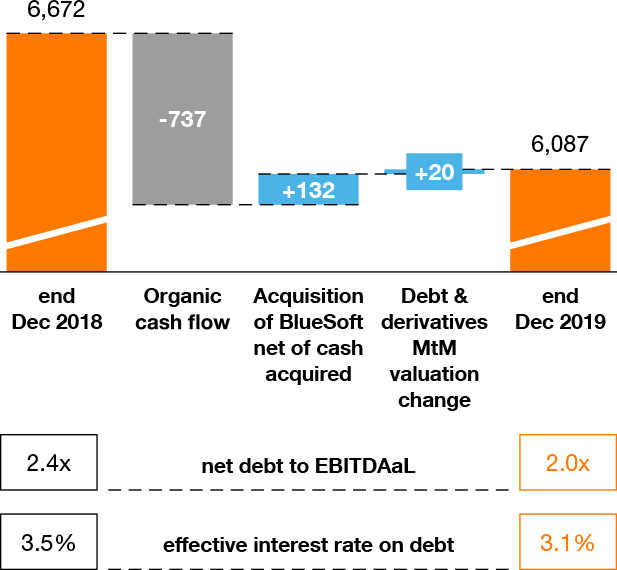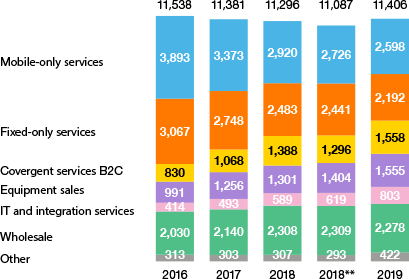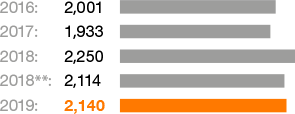Financial Key Performance Indicators (KPIs)
We use the following financial and operational KPIs to track Orange Polska’s performance
Data for 2016, 2017 and 2018 are presented according to IAS18*
* Please see information about accounting standards on page 55.
** 2018 comparable data.
*** Both adjusted EBITDA (until 2018) and EBITDAaL (from 2019) are key measures of operating profitability used by the Management Board.
2019 revenues up 2.9% year-on-year driven by convergence, ICT and equipment
In 2018, we changed the layout of our revenue reporting. The new layout better reflects our commercial strategy, which is focused on convergent offer sales. Consequently, we now report convergent revenues separately from revenues from mobile-only and fixed-only services (i.e. sales to non-convergent customers).
Revenues totalled PLN 11,406 million in 2019 and were up 2.9% or PLN 319 million year-on-year, despite continued structural pressure on legacy business lines (retail and wholesale fixed telephony). It was the first growth reported by the Company in 13 years. Convergence is a strategic driver for revenue growth.
Convergence revenues increased 20% year-on-year. This was accompanied by a decrease in mobile-only and fixed broadband- only revenues (down 5% year-on-year) as a result of migration to convergent offers, value and market competition. It is important to underline that the growth of convergent service revenues offsets the decline of mobile-only and fixed broadband-only revenues. Combined revenues from these categories were up 1.4% year-on-year in 2019.
Average revenue per convergent customer slightly increased year-on-year (0.4%), as compared to a 4% decline in 2018. The improvement is attributable to our focus on value and upsell of services.
Blended ARPO (from mobile-only services) amounted to PLN 20.1 in 2019 and was down 7% year-on-year. The decrease resulted from a combination of a 4% decline in prepaid ARPO and a 6% decline in post-paid ARPO. The postpaid ARPO decline was significantly lower than in 2018, when it was 10%. The trend improvement resulted from the following factors:
- Focus on value and related price increases (in line with our ‘more for more’ strategy) in both the consumer market (introduced in May 2019) and the business market (introduced to SOHO customers in November 2018);
- Lower penetration of mobile broadband in the mobile customer base; as a result, post-paid ARPO is less affected by substantial declines in mobile broadband ARPO (reflecting much lower take-up of this service).
Revenues from IT and integration services maintained their strong growth rate (30% year-on-year). This is consistent with our strategy, which sees very high growth potential in this area. The key growth engines are projects involving provision of professional services to the financial sector and an increase in public procurement. An important growth driver was the consolidation of BlueSoft (acquired in 2019), which contributed PLN 86 million to the Group’s revenues. Excluding the impact of BlueSoft, revenues from IT and integration services were up 16%.
Revenue evolution in 2019 was also influenced by the following factors:
- A further structural decline in fixed voice telephony legacy revenues (by 15% year-on-year);
- 11% growth of mobile equipment sales, mainly as a result of constant improvement of our offer (particularly the introduction of handset sales in instalments at any point during the lifetime of the service contract), and very good response to our Christmas promotions (driving Q4 revenues up 17% year-on-year);
- Very strong growth (over 40% year-on-year) in other revenues, boosted by successful development of our energy resale business;
- A 1% decrease in wholesale revenues due to lower revenues from national roaming (under the agreement with Play) and structural decline in revenues from traffic termination on the fixed network.
Revenue evolution (yoy change in PLN millions)

EBITDAaL increased for the second consecutive year, fuelled by record high gains on sale of assets, strong cost optimisations and improvement in direct margin
In 2019, total operating costs (defined as EBITDAaL less revenues) increased, but considerably less than revenues. As a result, EBITDAaL was up 7.0% year-on-year. Operating profit margin (ratio of EBITDAaL to revenues) increased by 1.1 percentage points to 26.4%. The growth was driven by higher gains on sale of real estate (up PLN 79 million). Nevertheless, both EBITDAaL and margin improved even excluding gains on sale of real estate, by 4.5% and 0.4 percentage points respectively. This was achieved despite the evolution of revenue mix towards lower margin, reflecting falling high-margin revenues from fixed line services and growing revenues from equipment sales, IT and integration services, and energy resale. However, profitability benefited from value-oriented commercial activity, monetisation of fibre investments and continued significant optimisation of indirect costs. Indirect costs (not directly related to revenues) fell in 2019 by almost 5% (excluding gains on sale of real estate).
Cost evolution can be attributed mainly to the following factors:
- An increase of 3% in commercial expenses, driven mainly by a higher volume of handset sales as a result of introducing an option to purchase handsets via an instalment scheme at any time during the lifetime of the service contract as well as our strategy of attracting customers with offers that include handsets;
- A decrease of 6% (year-on-year) in labour costs, mainly owing to workforce optimisation related to the implementation of the Social Agreement; and
- An increase of 21% in other external purchases, driven mainly by purchase costs of energy for further resale (related to higher revenues in this segment), content costs (resulting primarily from TV customer base expansion) and implementation costs of IT/IS projects (also related to revenues), as well as the consolidation of BlueSoft.
EBITDAaL evolution (yoy change in PLN millions)

Bottom line reflects strong EBITDAaL and restructuring provision for the new Social Plan
Net income for 2019 was PLN 91 million, a growth from PLN 10 million reported in 2018. Bottom line improved, despite the impact of a PLN 181 million provision to cover employment termination programmes. The improvement was driven by growth of EBITDAaL and PLN 93 million lower depreciation (mainly a consequence of extension of useful life of certain assets).
2019 Capex at PLN 2140 million, +1% year-on-year, consistent with strategy
The Group’s capital expenditures in 2019 (starting from 2019, this measure excludes capital expenditures related to leasing and is adjusted for the impact of acquisition of telecommunications licences) amounted to PLN 2,140 million and were higher by PLN 26 million year-on-year (excluding spectrum licence payments).
The Group invested mainly in the following areas:
- Rollout of the fibre access network as part of the ongoing investment programme, which covered 0.8 million households in 2019. Including the lines developed in 2014 to 2018, there are now 4.2 million households connectable with the fibre network, available in a total of 142 cities (compared to 117 cities at the end of 2018);
- Investments to enhance the range of LTE services and the quality of the mobile network, expand the capacity and range of GSM/UMTS services, and adapt the mobile access network to 4G technology requirements, particularly in the areas not covered by the mobile access network consolidation project (i.e. strategic or underinvested regions);
- Expansion of the mobile transport and core network in order to handle the growing volume of data transmission and ensure the service quality expected by customers;
- Implementation of transformation programmes;
- Investment projects related to portfolio development, sales and customer service processes, as well as the modernisation and enhancement of the IT technical infrastructure.
Split of CAPEX (PLN millions)

Organic cash flow reflects higher proceeds from asset disposals
Organic cash flow for 2019 was PLN 737 million, an improvement of PLN 326 million versus 2018. The growth was driven by PLN 344 million higher proceeds from sale of assets (mainly owing to the sale of the Nowogrodzka/ Barbary real estate complex). Cash capital expenditures at PLN 2,267 million were up PLN 106 million year-on-year, mainly as a result of different phasing of payments to capex suppliers. This growth was partly offset by higher working capital release, supported by sale of selected receivables arising from sales of mobile handsets in instalments (PLN 291 million).
Leverage ratio down to 2.0x
Our net debt in 2019 decreased by around PLN 0.6 billion to PLN 6.1 billion mainly due to higher cash generation. Our leverage ratio stood at 2.0x at the end of 2019, having strongly decreased over the previous 12 months. It reflects improving business fundamentals and balance sheet optimisation initiatives. Our debt was fully hedged against currency movements and we increased the share of debt based on a fixed interest rate to 96% from 93% at the end of 2018. Effective interest rate on debt dropped in 2019, as we increased the proportion of lower-cost hedging instruments.
Net debt evolution in PLN millions

Unchanged approach to dividends
In line with our statement during the Orange.one strategy presentation in September 2017, the Management Board will once again recommend not paying dividend in 2019. On the one hand, we prioritise investments in long-term value creation. On the other hand, we are taking into account that the 5G spectrum auction is imminent.
Revised definitions of Capex and EBITDAaL alternative performance measures
From 2020 reporting we will revise definitions of Capex and EBITDAaL alternative performance measures. Capex will be presented net of the proceeds from asset disposals and will be named economic Capex (eCapex). Consequently, EBITDAaL will exclude gains on asset disposals.
This change better reflects the transformation of Orange Polska’s fixed asset base, which has been rapidly evolving over the past few years. It will continue to do so in the future, as we invest in assets essential for our future value creation (fibre and mobile network) and dispose of assets no longer necessary for our core operations. The economic benefits of this transformation will be shifted from EBITDAaL to Capex.














